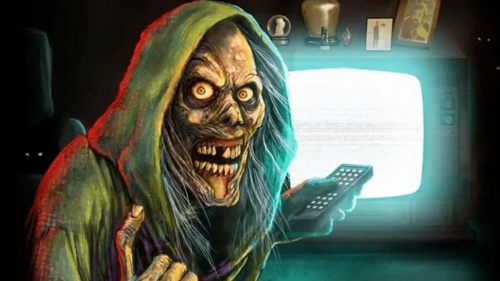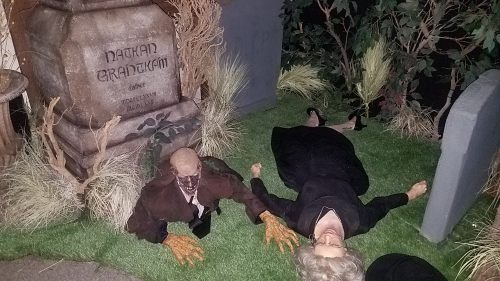Our Daily Trailer: CREEPSHOW
By 1982, Stephen King had only been adapted three times - by Brian De Palma in 1976’s Carrie; by Tobe Hooper in the 1979 TV miniseries 'Salem’s Lot; and by Stanley Kubrick in 1980’s The Shining. Though King would later become more candid about these adaptations, at the time he said "in all three cases I feel that I have been fairly treated . . . and yet the clearest emotion in my mind is not pleasure but a mental sigh of relief."
Creepshow was going to be different. On the cusp of an absolute landslide of Stephen King adaptations, here was a film based, for the first time, on an original screenplay by King. And unlike the previous adaptations, where King’s participation amounted to sitting in his Maine home and wondering how these strangers would represent his work, this time his pal George A. Romero was at the helm - and he was bringing King along for the ride.
King and Romero had recently become friends after a long-running mutual appreciation for each other. Romero was a vocal fan, going so far as to give King a cameo in 1981’s Knightriders. King had written effusively about Romero’s work in his 1981 nonfiction tome Danse Macabre. They were totally bros. And as King adaptations began turning up on the dance card of every name director in the horror field, it was probably inevitable he and Romero would cross paths creatively; in Creepshow, you get the sense that they both wanted to make it count.
In brief, Creepshow is like nothing either artist had ever done. A loving homage to the EC horror comics of the '50s, Creepshow is polished, colorful, funny and just pop as hell. It's where King and Romero, known for their realism and willingness to take audiences to dark, uncomfortable places, embrace the '80s aesthetic and add a giddy mean streak. If Jaws set off a sea change in Hollywood, giving rise to the age of the whiz-bang, crowdpleasing blockbuster, Creepshow was how King and Romero saw the phenomenon from the cheap seats of Bangor and Pittsburgh. George Lucas’ nostalgia for Flash Gordon serials begat Star Wars; Creepshow is the Romero and King version - warm and fuzzy nostalgia through a very peculiar, warped pair of lenses.
Attracting an impressive roster of character actors, as well as a young, disco-dancing Ed Harris, Creepshow has the manic energy of a sugared-up kid, telling its comic book stories so briskly that at times the camera actually jumps ahead a few panels in a rush to get to the “good parts.” It’s one of the most garishly colorful horror films since Suspiria. You'd be forgiven for assuming this to be a connection to occasional Romero collaborator Dario Argento, but it's more likely a byproduct of Romero’s love for 1951's film The Tales Of Hoffmann, a kaleidoscopic, Technicolor anthology by Michael Powell and Emeric Pressburger. And as an additional signifier that we’re not meant to take any of this too seriously, Romero puts King front and center in “The Lonesome Death of Jordy Verrill,” a story that is essentially fifteen minutes of King talking to himself in a heavy rural accent while turning into a giant weed. It’s amazing.
In "Father's Day," the family asshole sees no reason to retire after death. In "Something To Tide You Over," Ted Danson goes through a uniquely Romero-esque life cycle, much to Leslie Nielsen's consternation. If you have a bug phobia, maybe skip the last segment, "They're Creeping Up On You." All five stories have much to recommend them and complement each other well, but “The Crate” was the critical and popular favorite at the time. Its plot about unorthodox solutions to marital strife might rub some the wrong way today, but as I said, this movie is mean. It unapologetically delivers everything from Old Testament comeuppance for the wicked to cosmic horror upon the undeserving. Oh, and author Joe Hill is in the wraparound segment, getting slapped around by an uncredited Tom Atkins! Truly something for everyone.
And in a year when bleak horror wasn't particularly "in," the candy-colored Creepshow made enough money to warrant a sequel five years later. This time Romero took over scripting duties (adapting stories by King) and handed the director's chair to his longtime DP Michael Gornick. It has its fans, but to me Creepshow 2 felt like a murky, second-gen copy of the crackling original. A third film was released straight-to-video by the rights holders in 2007, and some sort of web short was released a year later. I’m sure someone will remake it at some point.
Romero and Laurel, the film’s production company, parlayed the success of Creepshow into Tales From The Darkside, a charmingly cheap horror anthology series that aired in first-run syndication from 1984 - 1988. There are 90 episodes; it’s a sporadic hoot. But perhaps the biggest benefactors of Creepshow were the A-listers who saw how well it performed financially, and snapped up the rights to the actual EC Comics that inspired it. In 1989 Tales From The Crypt was launched on HBO, ran for seven seasons and is fondly remembered today.
It can be argued that Creepshow was the last great film from George A Romero. Though many film fans (myself included) have a deep and lasting affection for 1985’s Day of the Dead, by all accounts it was not the film Romero set out to make, and the battle to get it to the screen indirectly led to the end of his partnership with producer Richard Rubinstein. Romero would go on to make other films, and even adapt more Stephen King, but in many ways Creepshow was the man’s last "big" success. It’s pretty safe to call this the last great thing from screenwriter/actor Stephen King as well, unless you’re huge fans of Maximum Overdrive and Sleepwalkers. (Pet Sematary is fondly recalled today, but is a sore spot for me, not because of King’s priest cameo, but because it was supposed to be the King/Romero reunion, only this time leaving the campy fun of Creepshow behind. Both guys were so, so passionate about it, talking it up in EVERY interview for a while. King hoped for a blend of Night Of The Living Dead’s nightmarish bleakness and Martin’s personal, existential dread. When it finally came together and Romero was no longer involved, I was heartbroken and super-biased against it. I’m due for a revisit.)
Today, Creepshow is available as a bare bones DVD, on Amazon Instant to rent or purchase, and in a tricked-out special edition Blu-ray in the UK. Someone at Warner Brothers should fix that.


